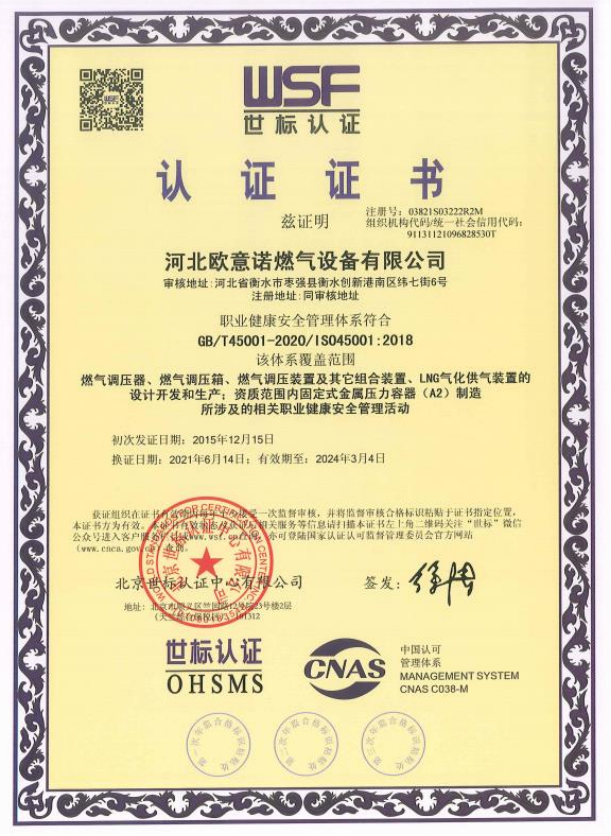
Dec . 31, 2024 05:02
Back to list
natural gas pressure reducing station
Natural Gas Pressure Reducing Stations A Key Component of Distribution Systems
Natural gas is one of the most significant energy sources used globally, providing heating, electricity generation, and fuel for various industrial processes. However, transporting natural gas from production sites to end-users involves careful management of pressure. High-pressure pipelines are essential for moving gas over long distances, but before the gas can be consumed, its pressure must be reduced to a safe and usable level. This is where natural gas pressure reducing stations come into play.
A natural gas pressure reducing station (PRDS) is a facility that is designed to decrease the high pressure of natural gas flowing through a pipeline to a lower, regulated pressure suitable for local distribution and residential use. The process of reducing pressure is critical as it ensures that the gas delivered to consumers is safe and meets the required operational standards.
Components of a Pressure Reducing Station
A typical pressure reducing station consists of several key components
1. Inlet and Outlet Piping The inlet piping connects the station to the high-pressure gas pipeline, while the outlet piping directs the reduced-pressure gas to the distribution network.
2. Pressure Regulators These devices are the heart of the reducing station. They automatically lower the pressure of the incoming gas to a specific level by using mechanical means. Regulators maintain a consistent outlet pressure, despite fluctuations in the inlet pressure or changes in the demand for gas.
3. Safety Devices Safety is paramount in any gas handling system. Various safety devices, such as pressure relief valves and shut-off valves, are incorporated into pressure reducing stations. Pressure relief valves help to vent excess gas in case pressure exceeds safe levels, while shut-off valves can quickly stop the flow of gas in an emergency.
natural gas pressure reducing station

4. Measurement Equipment Flow meters and pressure gauges are essential to monitor the flow rate and pressure of the gas entering and exiting the station. Accurate measurement ensures that the gas is delivered at the correct pressure and volume to meet consumer demand.
5. Control Systems Modern reducing stations are often equipped with advanced control systems that allow operators to monitor and manage gas pressure remotely. These systems enhance the efficiency of the operation and improve safety.
Importance in the Supply Chain
Pressure reducing stations are vital for several reasons. Firstly, they ensure safety by regulating the pressure of gas before it enters residential and commercial supply lines. High-pressure gas can be dangerous and potentially lead to catastrophic failures if not managed correctly.
Secondly, these stations play a significant role in maintaining the stability of the natural gas supply. As demand fluctuates throughout the day and across seasons, pressure regulators help accommodate these changes, ensuring a reliable supply of gas to consumers.
Lastly, pressure reducing stations enhance the efficiency of the gas distribution network. By optimizing pressure levels, these facilities reduce energy losses that can occur when gas is transported at higher pressures for extended distances.
Conclusion
Natural gas pressure reducing stations are a critical infrastructure component in the energy landscape. They not only ensure the safe delivery of gas to consumers but also enhance the overall efficiency and reliability of natural gas distribution systems. As the demand for natural gas continues to grow worldwide, optimizing the performance and security of pressure reducing stations will remain an ongoing priority for energy providers. Investing in modern technology and maintenance practices will further ensure that these facilities can meet future demands while maintaining safety and efficiency standards.
Latest news
-
Safety Valve Spring-Loaded Design Overpressure ProtectionNewsJul.25,2025
-
Precision Voltage Regulator AC5 Accuracy Grade PerformanceNewsJul.25,2025
-
Natural Gas Pressure Regulating Skid Industrial Pipeline ApplicationsNewsJul.25,2025
-
Natural Gas Filter Stainless Steel Mesh Element DesignNewsJul.25,2025
-
Gas Pressure Regulator Valve Direct-Acting Spring-Loaded DesignNewsJul.25,2025
-
Decompression Equipment Multi-Stage Heat Exchange System DesignNewsJul.25,2025

